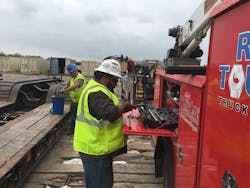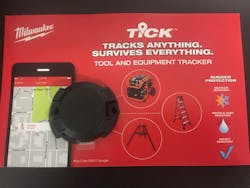By now, everyone knows the basic benefits of asset management using GPS and telematics systems. There are opportunities to gauge productivity, control costs, improve safety, and better manage maintenance, just to name a few.
But one segment that can be overlooked is the tracking of small equipment—items like trailers, generator sets, light towers, attachments, tools, and arrow boards—assets that can easily go missing.
These assets can be forgotten at job sites and therefore underutilized. In addition, they are often targets for theft or can simply be lost. Whatever happens, it is lost productivity and profit, and replacing the items will cost an operation even more money.
GPS tracking can give instant, real-time feedback on an item’s location; something hub meters (that measure travel distance) or hour meters cannot do.
Consider GPS equipment tracking devices to look after tools, trailers, attachments, construction materials, and more.
It also allows the establishment of geofences, geographical boundaries that are set by a manager to control where a piece of equipment may be used. If an asset crosses a boundary, the manager is alerted on a cell phone or other device.
This is useful to combat not only theft, but also employees “moonlighting,” using the equipment or tools for personal reasons.
How many construction tools are recovered?
The National Insurance Crime Bureau (NICB) says as much as $1 billion a year is lost nationwide from the the theft of equipment and tools, with a recovery rate that is less than 20 percent.
It says thieves target construction sites for five main reasons: the value of equipment; poor equipment and site security; opportunities to sell stolen equipment in the used equipment market; low risk of detection and arrest; and lenient penalties for thieves if prosecuted and convicted.
Why you need GPS equipment tracking devices
“Whether you need to protect your property from thieves or moonlighting employees, using fleet tracking technology can help you eliminate the worry and minimize risk,” says Zoe Burris of GPS Trackit.
“Having tools that are designed to protect your assets from external theft and internal issues can potentially save you hundreds of thousands of dollars per year,” she says. “Many managers in the fleet and construction management industry can attest to the problem of theft and employee misuse of equipment. With the proper telematics tools, you can also protect your brands’ assets from any associated liabilities.”
Mathew Long, product success at Verizon Connect, says tracking is an important investment, “especially [for] those in the construction industry with hundreds of pieces of equipment.”
“With asset tracking, business owners have the peace of mind of knowing where equipment is during the day and as it moves to different locations or jobs,” Long says. “Plus, having the ability to track valuable assets can help reduce the risk of theft and can help increase recovery if equipment is stolen. Fleet managers can also use the same technology to track equipment during the day to alert the authorities to recover what was stolen.”
Trackimo’s Amanda Thomas keys in on the costs of not using technology.
“Employing more security personnel to guard construction sites can be very costly, which is why most contractors avoid hiring a lot and they end up not hiring enough to keep the place safe,” she says.
Surveillance cameras, besides being expensive, are not enough to eliminate the possibility of equipment being stolen.
“To solve the problem, construction businesses turn to GPS trackers,” Thomas says. “Each tracker has an estimated value of $140, so say a construction site has 100 pieces of equipment to monitor, the average annual cost is expected to be around $14,000 only. This is way lower than having to spend $26,400 annually on each guard, making GPS tracking devices a more efficient solution to construction equipment theft.”
Another advantage to GPS for equipment, Thomas says, is 24-hour monitoring. GPS tracking devices don’t take lunch or bathroom breaks.
“Before GPS trackers, monitoring construction equipment was never as easy as a simple press of a button,” Thomas says. “By attaching one tracker to each construction tool, business owners are made aware of the equipment’s real-time location and condition. Anyone who has access to the tracker and the data it gathers will know the subject’s whereabouts, even when they’re far from the workplace.
“Bosses will know if the equipment isn’t where it should be and can call construction managers to inquire about it,” Thomas says.
When an equipment is in transit, there’s a possibility that the transporting vehicle will enter a gray area where there is very limited cellular service. “In this case, it will be very difficult to communicate with the drivers and foremen,” Thomas says. “Situations like this are the perfect opportunity for thieves to attack and steal whatever they can. But with GPS tracking devices like Trackimo, location tracking remains convenient and accessible anytime, anywhere, as long as GSM cellular reception exists, ensuring that the equipment never go off the radar.”
There are also satellite connections possible for some GPS tracking devices when cellular reception isn’t available. Another GPS tracking benefit is inventory tracking and control.
“Usually, construction companies fail to report missing equipment because most of the time, they don’t even know it was missing in the first place,” Thomas says. “It’s only when they actually need the equipment that they notice it has been gone for quite a while. This is one of the most common problems at construction sites that do not perform daily inventory.”
GPS trackers for inventory control
GPS tracking also makes inventory control easier. Tool tracking systems can eliminate the need for those in charge of inventory to visit sites, or otherwise do tedious detective work to find assets.
“The purposes GPS tracking devices serve are not limited to tracking and monitoring,” Thomas says. “Most devices also come with an alert system. On a programmed software or mobile application, construction owners can set those geofences so when any equipment approaches or exits the area, it will trigger an alert. This is a preventive measure for construction equipment theft.”
Some tracking equipment may be sensitive enough to tell managers if a tool that was inside a building on a job site is suddenly taken outside, by “knowing” parameters other than a geofence.
“The Verizon Cat-M1 Enterprise Asset Tracker provides near real-time location alerts for trailers and other non-powered assets, and notifies fleet managers in the event of significant changes to the asset’s temperature, tilt, vibration, shock, humidity, light, and pressure,” Long says.
Trailers and mobile offices are also targets. “Large and small appliances like refrigerators and microwaves are often stolen from sites that haven’t been secured,” Burris says. “It’s important to secure sites to prevent theft of these costly items.”
Managers who may also have to look after construction materials as well as equipment and tools on sites should know that GPS tracking equipment is now small enough to be hidden in materials. Metals and wood attract unwanted attention.
“Copper is the most commonly sought after metal for thieves searching construction sites,” Burris says. “Its increase from $0.80 a pound to $4 a pound in recent years is what keeps thieves scouring sites for scraps. Using telematics can help deter and track thieves searching your construction site.”
Wood is often targeted by employees. “When it comes to moonlighting, this is the most commonly stolen item from construction sites by employees,” Burris says. “Construction employees often pilfer lumber pieces from the site and use them to supply side jobs. Pieces of wood can be protected using telematics software that detects when anything leaves your work site.”
Whether it’s equipment, trailers, tools, or materials, the financial toll alone suggests managers take a hard look at GPS tracking.
“With big bucks attached to every piece, it is necessary for every enterprise to come up with effective ways to protect their assets,” Thomas says. “In the event of a loss, replacement is just the beginning of the dilemma. Business owners can only hope their insurance covers replacement.
“Apart from that, there’s also the time spent on the rigorous process of filing police reports and insurance claims,” Thomas says. “Using GPS asset tracking is here to save you from having to go through all that. Just attach monitoring devices to your assets and technology will do the rest.”







